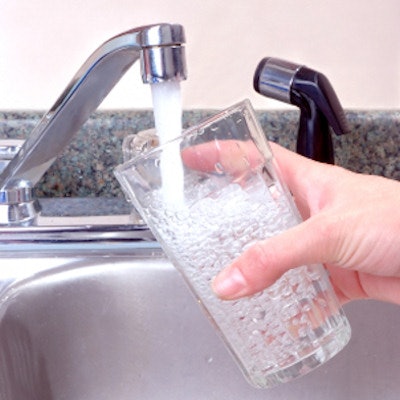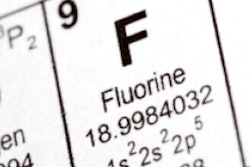
U.S. children and adolescents who drank tap water had a higher prevalence of elevated blood lead levels but a much lower rate of dental caries than those who did not drink tap water, according to a new survey. The researchers suggest large parts of the U.S. population do not believe their drinking water is safe.
Overall, nearly 3% of children and adolescents had elevated blood lead levels and 49.8% had tooth decay. The study was published in the American Journal of Public Medicine (November 27, 2017).
"Community water fluoridation benefits all people, irrespective of their income or ability to obtain routine dental care," stated study co-author Gary Slade, BDSc, PhD, in a press release accompanying the survey results. "Yet we jeopardize this public good when people have any reason to believe their drinking water is unsafe."
Dr. Slade was joined in the study by Anne Sanders, PhD, both of whom are affiliated with the department of dental ecology at the University of North Carolina at Chapel Hill.
Tapped out?
The researchers wanted to determine if nonconsumption of tap water was associated with a lower prevalence of elevated blood lead levels and higher prevalence of dental caries in children and adolescents.
They used cross-sectional data from the 2005-2014 National Health and Nutrition Examination Survey (NHANES) that recorded drinking water source (n = 15,604) and blood lead levels (n = 12,373) for participants ages 2 to 19 years, as well as any dental caries experience for the 2011-2014 subset of those surveyed (n = 5,677). In this survey, the threshold for elevated blood lead level was 3 µg/dL or greater.
The researchers found that 15% of children and adolescents in the survey did not drink tap water. A little more than 21% of preschoolers did not drink tap water compared with a little more than 11% in adolescents.
Overall, 3% of the children and adolescents had elevated blood lead levels, while half had dental caries (see table below).
| Elevated blood levels and dental caries by age | ||||||
| 2-5 years | 6-11 years | 12-19 years | ||||
| Drinks tap water | Does not drink tap water | Drinks tap water | Does not drink tap water | Drinks tap water | Does not drink tap water | |
| Elevated blood lead level | 6.9% | 4.0% | 2.8% | 2.4% | 1.5% | 1.3% |
| One or more teeth with dental caries | 20.5% | 31.8% | 53.1% | 63.1% | 59.2% | 65.9% |
"Elevated blood lead levels affect only a small minority of children, but the health consequences are profound and permanent," Sanders stated. "On the other hand, tooth decay affects 1 in every 2 children, and its consequences, such as toothache, are immediate and costly to treat."
“Community water fluoridation benefits all people, irrespective of their income or ability to obtain routine dental care.”
One of the most striking results, according to the study authors, was the variation in nonconsumption of tap water among racial/ethnic groups:
- Non-Hispanic white -- 8.0% did not consume tap water
- Other/multiple racial identity -- 12.4% did not consume tap water
- Non-Hispanic black -- 21.5% did not consume tap water
- Other Hispanic -- 26.9% did not consume tap water
- Mexican American -- 32.2% did not consume tap water
The authors also reported that as depth of poverty increased, the less likely it was that tap water would be consumed:
- Below poverty threshold -- 22.6% did not consume tap water
- Near poverty threshold -- 16.1% did not consume tap water
- Not poor category -- 10.3% did not consume tap water
- 500% above poverty threshold -- 6.4% did not consume tap water
- Income not reported -- 20.4% did not consume tap water
Social differences
The authors cited two major limitations to their study:
- Unmeasured lead exposures (such as lead-laden paint chips and dust, gasoline, and solder) could impact the relationship between tap water and blood lead level.
- The fluoridation status of participants' tap water was not known.
Pediatric dentist Johnny Johnson Jr., DMD, president of the American Fluoridation Society, wrote DrBicuspid.com in an email that he would recommend that all healthcare professionals continue to recommend drinking tap water.
"If there is concern with potential lead exposure, encourage the family to get their water tested," he wrote. "The local health department office is where I'd suggest they start to find out how to get it tested."
Dr. Johnson also suggested the use of inexpensive water filters, such as faucet attachments or pitcher-based models, to ensure the safety of the water on a personal level. The models will specifically state that they remove almost 100% of lead. The filters should also state that they do not remove fluoride.
The study authors noted that social differences in tap water consumption coincide with contextual risk factors such as inadequate maintenance of water infrastructure, poorly enforced regulation, and substandard housing limit access to piped potable water. These factors compound the health risks for disadvantaged groups lacking opportunity to relocate to safer, more desirable residential areas.
"Our study draws attention to a critical trade-off for parents: Children who drink tap water are more likely to have elevated blood lead levels, yet children who avoid tap water are more likely to have tooth decay," Slade stated.



















